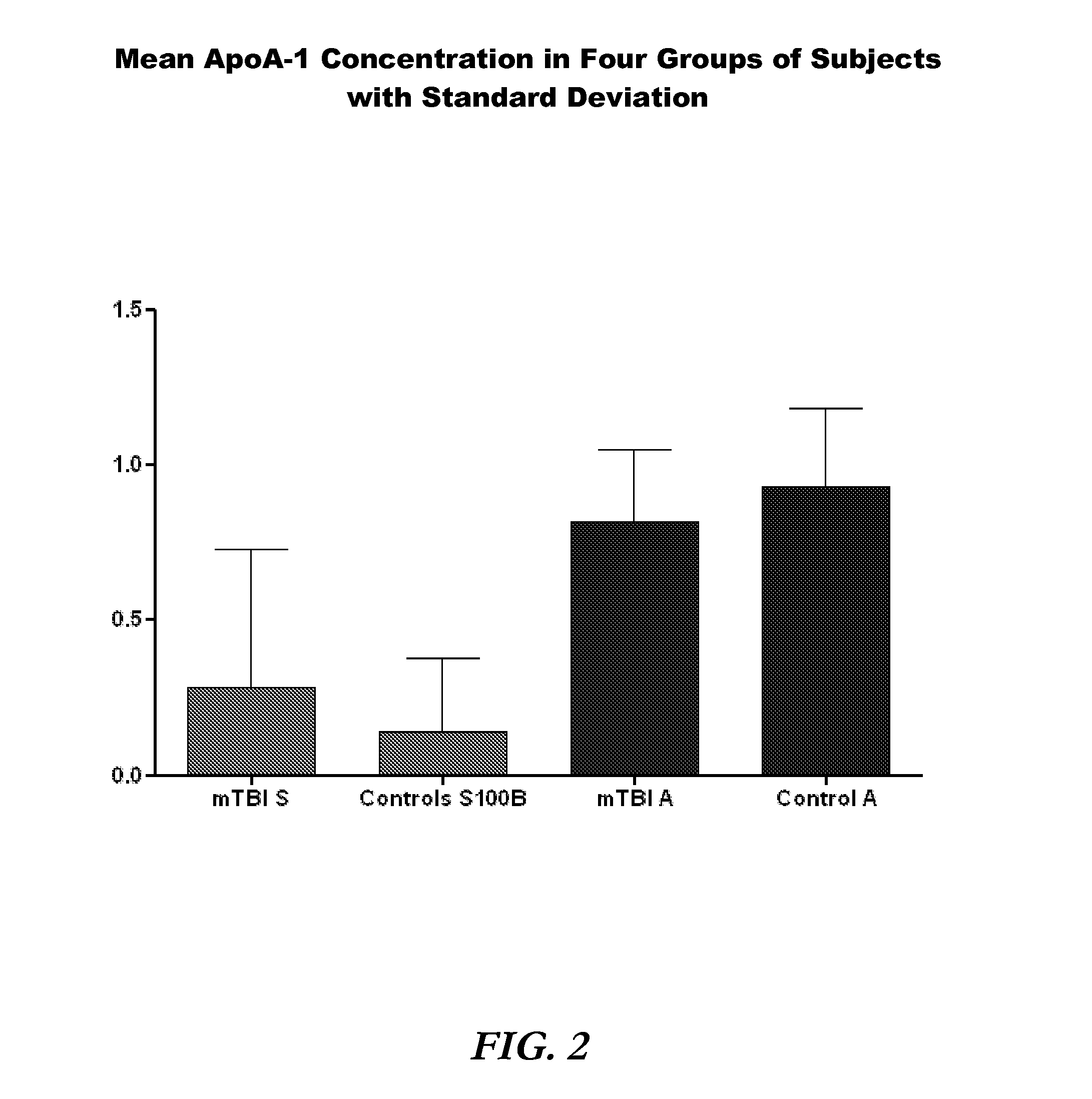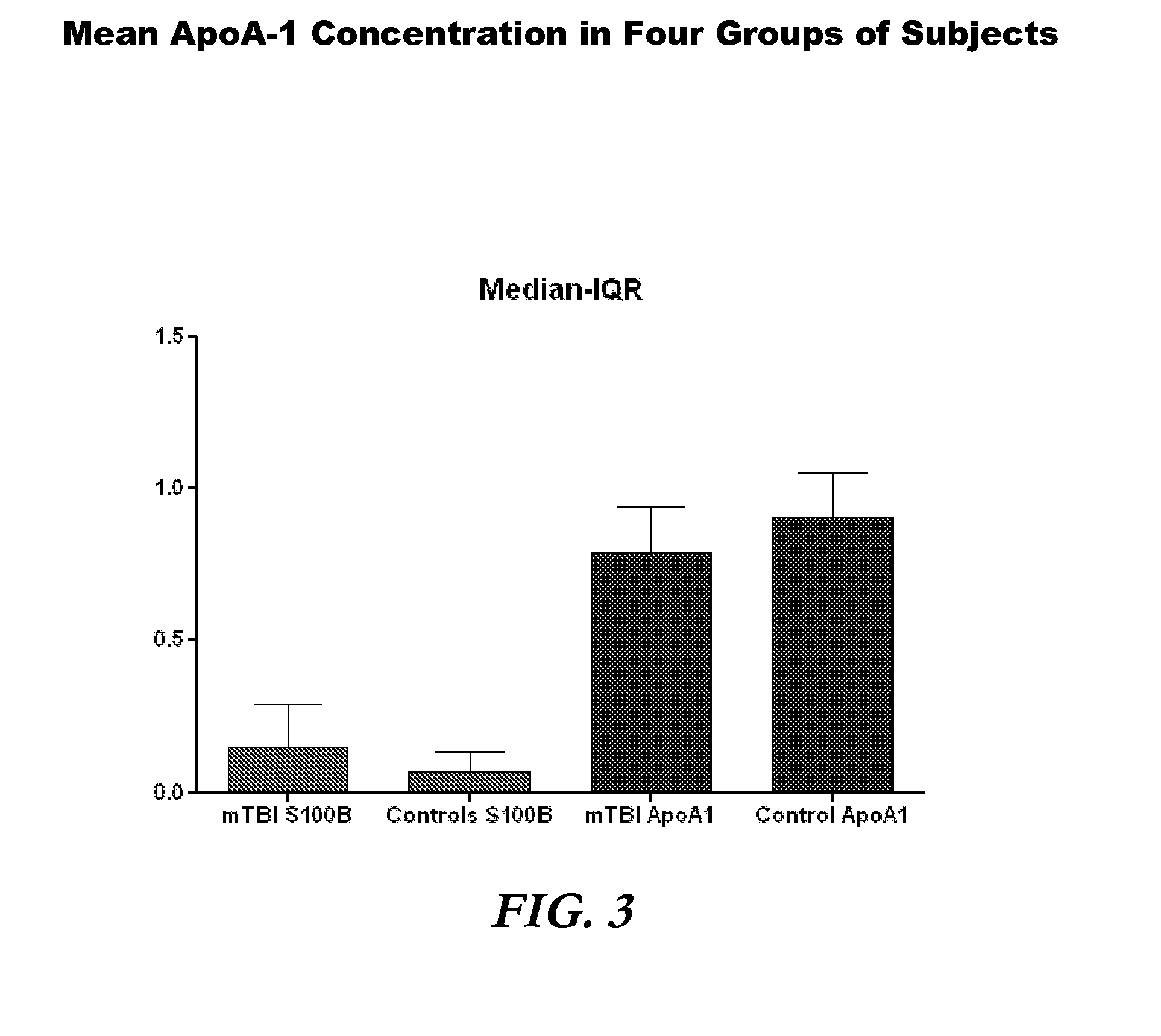Method of diagnosing mild traumatic brain injury
a brain injury and mild technology, applied in the field of mild traumatic brain injury diagnosis, can solve the problems of complicated clinical diagnosis of mtbi, willful misreporting of symptoms, and other problems, and achieve the effect of less accura
- Summary
- Abstract
- Description
- Claims
- Application Information
AI Technical Summary
Benefits of technology
Problems solved by technology
Method used
Image
Examples
example 1
ApoA-1 as a Marker for mTBI
[0089]ApoA-1 was initially identified as a potential mTBI biomarker through a proteomic screen of sera collected from mTBI subjects. This screening study was designed to identify acute protein expression differences in mTBI subjects who subsequently develop post concussive symptoms relative to those who do not. Using mass spectroscopy, apoA-1 was identified as a differentially expressed protein in mTBI subjects. Verification of the relationship between acute apoA-1 concentrations and post concussive symptoms was then evaluated by measuring apoA-1 concentrations in a larger cohort.
[0090]A total of 1254 subjects were enrolled (787 mTBI, 467 control). ApoA-1 concentrations were measured in 1241 of these subjects. ApoA-1 concentrations ranged from 0.10 to 2.20 mg / ml in mTBI and 0.30 to 2.92 mg / ml in control subjects (FIG. 1). Mean apoA-1 concentrations were 0.84 mg / ml (SD 0.25) and 0.95 mg / ml (SD 0.26) in mTBI and control subjects, respectively (FIG. 2). Media...
example 2
S100B Concentrations in mTBI Subjects
[0091]The only blood biomarker in clinical use with TBI is S100B, which is used widely in Europe but is not yet approved in the United States. Serum concentrations of this predominantly glial protein measured within 6 hours of injury are very sensitive for the identification of mTBI patients with traumatic injury detectable by cranial computed tomography scans (Biberthaler et al., “Serum S-100B Concentration Provides Additional Information for the Indication of Computed Tomography in Patients After Minor Head Injury: A Prospective Multicenter Study,”Shock 25:446-453 (2006), which is hereby incorporated by reference in its entirety). The accuracy of this test as a surrogate for clinical diagnosis is unclear, however.
[0092]A total of 1254 subjects were enrolled (787 mTBI, 467 control). S100B concentrations were measured in 1248 of these subjects. S100B concentrations ranged from 0 to 3.89 μg / L in mTBI and 0.01 to 3.13 μg / L in control subjects (FIG....
example 3
Combining S100B and apoA-1 Concentrations Increases the Number of Subjects Correctly Classified
[0093]Elevated serum S100B concentrations are a surrogate for blood brain barrier function (Blyth et al., “Validation of Serum Markers for Blood Brain Barrier Disruption in Traumatic Brain Injury,”Journal of Neurotrauma 26:1497-1507 (2009), which is hereby incorporated by reference in its entirety). The blood brain barrier keeps brain derived proteins such as S100B from entering the peripheral circulation. The blood brain barrier can be referred to as “open” when S100B levels are elevated. ApoA-1 originates in the liver and bowel and is not made or produced in the brain. It is believed that apoA-1 might improve test accuracy by correctly classifying mTBI subjects with normal blood brain barrier function. ApoA-1 concentrations are significantly different between subjects with open vs. closed blood brain barrier (FIG. 5). Scatter plots of S100B vs. apoA-1 concentrations with the shaded areas...
PUM
| Property | Measurement | Unit |
|---|---|---|
| concentrations | aaaaa | aaaaa |
| concentrations | aaaaa | aaaaa |
| concentrations | aaaaa | aaaaa |
Abstract
Description
Claims
Application Information
 Login to View More
Login to View More - R&D
- Intellectual Property
- Life Sciences
- Materials
- Tech Scout
- Unparalleled Data Quality
- Higher Quality Content
- 60% Fewer Hallucinations
Browse by: Latest US Patents, China's latest patents, Technical Efficacy Thesaurus, Application Domain, Technology Topic, Popular Technical Reports.
© 2025 PatSnap. All rights reserved.Legal|Privacy policy|Modern Slavery Act Transparency Statement|Sitemap|About US| Contact US: help@patsnap.com



